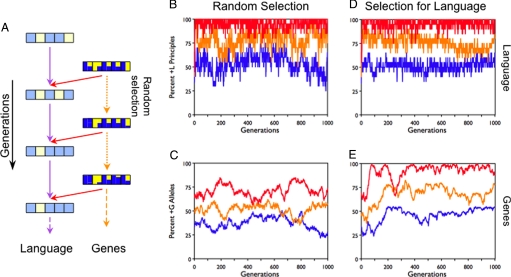Fig. 4.
The shaping of language by genetic influence. (A) Influence across generations is as in Fig. 3, except that the genes are no longer influenced by language or any other selective pressure. The genes of randomly chosen agents are sexually recombined and mutated (orange dotted arrows), leading to genetic drift. (B) The percentage of +L principles in the language, as a function of number of generations. The interaction between high population influence (g = 50%) and previous genetic biases is determined by varying the probability of allele reassignment during mutation. The neutral ?G allele always has a probability of 1/3. The +G allele has a mutation reassignment probability of 2/3, 1/2, or 1/3. The initial proportion of +G alleles is set to be the same as the mutation reassignment probability, with the remaining parameters taking the default values from Figs. 1–3. There are three degrees of +G bias: strong (2/3, red line), medium (1/2, orange), and none (1/3, blue). The previous genetic bias toward +G is reflected in the proportion of +L principles; language becomes aligned with the genes even when there is no selective feedback from language to genes. (C) The percentage of +G alleles in the population, plotted across generations. The genes follow a random-walk distribution, based on the reassignment probabilities for +G. (D and E) For comparison, the simulations in (B) and (C) were rerun, but with selection for language reintroduced (as in Fig. 3). Comparing (B) and (C) with (D) and (E) shows that with strong population influence, language simply converges on the initial genetic bias of the population (+G) regardless of whether or not genes are selected for language (as in the Baldwin effect).

